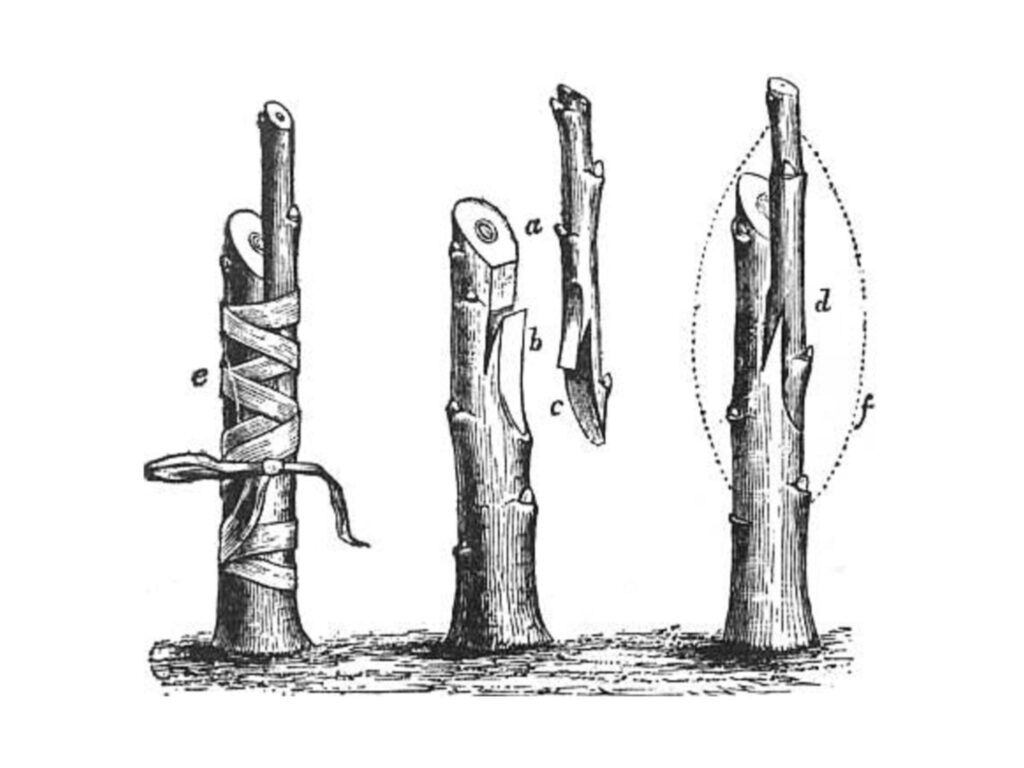How to Get Skin in the Game and Propagate Trees
This post contains affiliate links. As a member of Amazon Associates, I may earn a commission from qualifying purchases at no cost to you.
The pawpaw industry is at an important inflection point. To grow the market, we need more fruit. To produce more fruit, we need to propagate more hardy, disease-resistant trees with superior taste profiles. This is where the time-honored skill of grafting comes into play.
There are several strong reasons to graft:
- The demand for pawpaw trees has created a supply crunch.
- Grafting is a cost-effective alternative to purchasing nursery stock.
- We can help keep heritage cultivars from becoming lost to history.
The aim of this post is to share information and expand our community of pawpaw grafters, especially new growers and younger generations.
Types of Grafts
For a straightforward guide, pick up a copy of Grafting Fruit Trees: Storey’s Country Wisdom Bulletin. This booklet covers a lot of basic information with helpful illustrations and FAQs.
Don’t worry about trial and error. Kentucky State University has already done the heavy lifting with research on the best techniques for pawpaws:
Grafting Method / Grafting Success Rate *
- Whip & Tongue / 95.8%
- Topgrafter / 66.6%
- Chip Bud / 54.1%
- T-Bud / 37.5%
- Green Bud / 0.0%
* KYSUAG. “September 2021- Third Thursday Thing and 3rd Annual #NationalPawpawDay.” YouTube, September 16, 2021, https://www.youtube.com/watch?v=riL5gj2DQTU&t=2s.
Pro Tip: check with your local cooperative extension service office for resources from land-grant universities.
Learning to Graft
Members of the North America Pawpaw Growers Association (NAPGA) can attend annual meetings that include demonstrations and training from veteran grafters. The instruction is hands-on and in small groups, which allows for personalized attention. All the supplies – including scion wood and trees – are provided by the group.
Other non-profit organizations with pawpaw experts:
- Backyard Fruit Growers
- California Rare Fruit Growers
- Indiana Nut and Fruit Growers Association
- Michigan Nut & Fruit Growers Association
- Ohio Nut Growers Association
A YouTube video is worth a thousand words. Here are a few stand-out examples of different grafting approaches:
Whip & Tongue
Get ready to hit “pause” and “replay” ad infinitum – but it’s worth it! The master grafters at Stark Bro’s Nurseries are incredibly fast and efficient. This 36-second “day in the life” video is short but full of valuable insights.
Cleft Graft
Sarah Francino provides a detailed demonstration at OSU South Centers in Piketon, OH. In the video, there is a view of the pawpaw orchard (established in 2018) with “high input” production treatments such as weed barrier fabric and drip irrigation.
Chip Budding
Sheri Crabtree grafts a bud chip to a rootstock, a technique that is a popular at many commercial nurseries. Kentucky State University has three trademarked cultivars: KSU-Atwood (shown here), KSU-Benson, and KSU-Chappell.
Tool & Supply Checklist
Here are the essentials to gather in preparation for grafting:
Grafting Knife
There is no “right” or “wrong” grafting knife. The decision is a strong personal preference, depending on skill and comfort level.
A large selection of grafting knives is available at gardening supply companies such as A.M. Leonard, Gempler’s, and Garrett Wade. Also, trusted brands like Felco have product offerings to shop.
Other grafters opt for basic – but just as effective – favorites such as utility knives (aka box cutters), multi-cut tools, or disposable scalpels.
The Italian grafting tool is widely used by apple and pear growers; however, there are mixed reviews for effectiveness with pawpaws.
Grafting Tape
A word of advice: don’t skimp on grafting film!
A lot of low-cost options have entered the market but beware of quality issues. While the branded tapes are more expensive, consider it an investment to protect your trees with a durable and secure wrap.
Buddy Tape was developed in Japan in 1985. This product is more expensive (single rolls start at $40) but there are big fans in the nursery industry.
Parafilm is produced by Bemis Company, Inc. in Neenah, WI. Choices include the nursery grafting tape (rolls) or all-purpose laboratory film (perforated sections).
Additional supplies to have on hand include large rubber bands (to loop over and tightly bond the graft union) and aluminum foil (to shield the graft union against ultraviolet light while the tissue callouses).
Plant Tags
This is sometimes an afterthought but don’t forget the important task of labeling.
There are a range of options including simple plastic wrap-around tags to longer-term solutions like aluminum plant labels or metal tape embossing kits.
Sharpies are a must-have in gardening belts and toolboxes, but the ink will fade faster than expected in the outdoors. Better alternatives for plastic tags include grease markers, pencils, or paint pens from hobby stores.
Sanitizing and First Aid
During the grafting process, it’s important to maintain clean surfaces, tools, and hands. Use alcohol prep pads to sanitize blades between each tree.
Whether you’re a beginner or pro, keep a first aid kit nearby for unexpected slips or knicks. In case of potentially serious injuries, carry clotting gauze or wound sealing powder as back up treatment. Better safe than sorry!
Scion Wood and Rootstock
Prepare to roll up your sleeves. The work to secure scion wood and rootstock can be a challenge and requires organization and advanced planning.
Scion Wood
Think of Black Friday as the kick-off to the holiday shopping season – and pre-ordering scion wood. Not sure where to start? Check Peterson Pawpaws and Kentucky State University for a list of nurseries that are already licensed to sell trademarked cultivars.
Alternatively, collect scion wood from dormant trees in late February to early March when temperatures have been above freezing for one or two days. Cuttings should be kept moist and stored in an airtight bag in the refrigerator until ready to use. Importantly, be careful to avoid fruits that release ethylene gas (e.g., apples, bananas, melons, pears, and peaches).
Rootstock
There are several considerations or strategies for rootstock. Are you planning to introduce genetic diversity or superior cultivars to an existing woodland property? Are you growing your own rootstock from seeds? Are you planning to order bareroot trees?
For bulk purchases, you’ll need to identify your source up to a year in advance. Based on current demand, the market for strong and healthy bareroot plants is tight.
There are several state agencies that offer bareroot tree bundles at very affordable prices; however, you need to research pre-order dates and mark your calendars. Some sales are limited to in-state residents so be sure to read the rules.
Indiana Department of Natural Resources
402 West Washington Street
Indianapolis, IN 46204
Telephone: (317) 232-4200
The Kentucky Division of Forestry
300 Sower Blvd
Frankfort, KY 40601
To order seedlings, contact your local regional office
Missouri Department of Conservation
George O. White State Forest Nursery
14027 Shafer Road
PO Box 119
Licking, MO 65542
Telephone: (573) 674-3229
Virginia Department of Forestry
900 Natural Resources Drive
Charlottesville, Virginia 22903
Telephone: (434) 977-6555
Email: nursery@dof.virginia.gov
Additional Resources
Looking for more information on growing pawpaws? Check out Ten Tips to Help Your Pawpaws Thrive on our blog page.
Also, find essential pawpaw information at our blog
- Download our Pawpaw Festival & Event Directory
- Learn about propagation, fruit processing, and other research
- A curated collection of news articles and videos
- Recommended reading list


